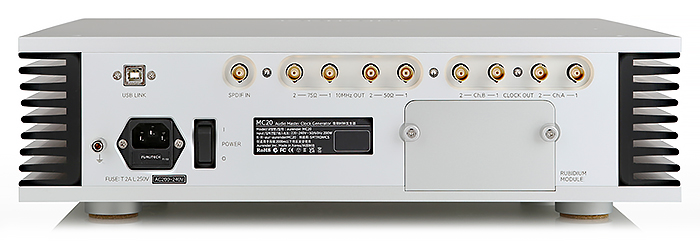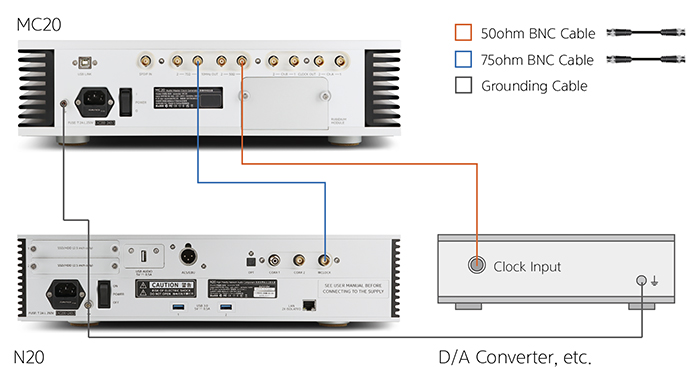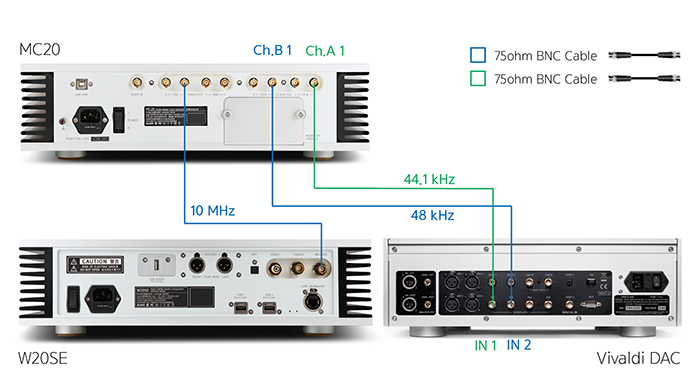|
- Reference Grade
Master Clock & Word Clock Generator
- Rubidium Module 10 MHz Master
Clock
- Discrete OCXO Word Clock Outputs
for Universal Connectivity
Time Is Of The Essence
In any digital audio system, the
rate at which digital data is
transmitted and received is of the
utmost importance. Specifically, all
devices in the digital signal path
must be synchronized in order to
provide a coherent presentation.
Therefore, for the ultimate
experience in clarity, transparency,
focused imaging, and natural realism,
your system’s digital source, DAC,
and any other upsamplers or
converters should all receive the
same synchronized clock signal from
an ultra precise and stable source.
The Aurender MC20 is both a Master
Clock and Word Clock generator that
is inspired, developed, and designed
to deliver an exceptionally high
level of digital audio realism from
a connected music server and/or D/A
converter. Thanks to the MC20’s
superior timekeeping, jitter is
reduced to infinitesimal levels
resulting in the ultimate timbral
purity and rock-steady placement of
instruments within your system’s
soundstage.
At the heart of the MC20 is a
rubidium module that generates a
10MHz master clock reference signal.
A rubidium clock is employed for its
superior accuracy and stability in
both the long and short term for
ultra-low jitter. Additionally, MC20
contains two discrete OCXO word
clock modules for generating the
frequencies 44.1 kHz and 48 kHz.
MC20 will independently and
simultaneously supply the four 10MHz
master clock outputs and four Word
Clock outputs (2 at 44.1 kHz and 2
at 48 kHz) for unprecedented
versatility with a wide variety of
Aurender and third party equipment.
Therefore, the MC20 can be used in
the following scenarios:
1 - Simultaneously supply a 10MHz
master clock reference signal to
source devices such as Aurender
music servers, DACs, and even
separate word clocks with 10MHz
master clock reference input.
2 - Supply a 10MHz master clock to
source devices such as an Aurender
Music Server and word clock to DAC
3 - Supply word clock to the source
device and DAC
Rubidium Clock Module
The rubidium clock module
employed in the MC20 is an
exceptionally stable and accurate
design that establishes a new low
level of phase noise and jitter. Its
flawless performance delivers a new
level of vivid clarity with a
three-dimensional width, depth, and
height to the sound field it creates.
The reduction of jitter and phase
noise removes any trace of “digital
glare,” and instead provides an
analog-style warmth and naturalism
to any digital audio source.
Rubidium modules are high-precision
devices, and they are extremely
delicate instruments. Consequently,
Aurender engineers have designed a
unique shock-mounted housing system
to secure the module and isolate
from vibrations both within the
chassis and in the surrounding
environment. To ensure the rubidium
module can be safely transported, it
arrives in its own foam case within
the MC20’s master carton. Upon
unpacking, the module will need to
be installed by the user and locked
into its dedicated chamber before
use.
Oven-Controlled Crystal Oscillator (OCXO)
for Long Term Jitter Reduction
While the rubidium module takes care
of MC20’s 10 MHz master clock
generator signal, Aurender’s
hallmark OCXO modules control
individual word clock output. OCXOs
are among the most accurate and
stable clocks in use today. The OCXO
modules deployed by Aurender’s
engineers are orders of magnitude
more accurate and stable than
commonly used ordinary crystal
oscillators usually found in
computers. Temperature changes can
cause crystal oscillations to
fluctuate and induce jitter in the
digital audio signal. Moreover,
ordinary crystals are much less
stable and lose accuracy over time.
In OCXO clocks, a very stable high
grade crystal oscillator is enclosed
in a temperature-controlled
compartment and kept at a constant
temperature to mitigate jitter.
Connectivity – 10MHz Sine Wave
Clock Outputs
A 10MHz master clock signal works as
a reference signal which informs
Aurender’s OCXO clock for greater
accuracy and stability over both the
short and long term. Since
Aurender’s clock input has an
impedance of 75Ω, connect the MC20’s
75Ω impedance 10MHz Master Clock to
the clock input terminal on the
Aurender server. By both measurement
and listening tests the 10MHz output
of the rubidium clock delivers
higher performance than other
methods. It is highly recommended!

Aurender N20 If the
DAC allows, it is recommended to use
a 10MHz Master Clock. Otherwise, use
the individualized word clock
outputs. Choose the 75Ω or 50Ω
outputs depending on the DAC’s input
impedance. In order to avoid signal
loss and / or jitter, it is
important to match cable impedance.
In a scenario where the DAC has a
word clock input(s), you can connect
the 10MHz Master Clock output to
your Aurender and simultaneously a
Word Clock output to the DAC.
Connect the SPDIF BNC output of your
source to MC20 for automatic
frequency synchronization depending
on whether you are playing a 44.1 or
48 kHz base file.

Connectivity and Compatibility
with Associated Components
MC20 can be used with a wide range
of associated high-end brands of
DACs and music servers. Current
Aurender models supporting MC20 are
N20, W20SE and N30/N30SA which all
have a 75Ω clock input.

For interfacing with an Aurender, or
another manufacturers’ components,
two pairs each of 75Ω and 50Ω SPDIF
cables are supplied. Please refer to
the owner’s manual of any equipment
that will receive clock input from
MC20 to determine which impedance
cable should be used.

Interfacing with dCS DAC &
Vivaldi Clock
If you are using a Vivaldi
Clock, it is also recommend to
connect
75Ω 10MHz Master Clock output to
Vivaldi Master Clock input.
More info:
MC20 Manual Page
Specifications
SPDIF Sync Input: Coaxial BNC,
75Ω (BNC 75Ω)
Clock Output:
- Rubidium Master Clock: 10MHz 2ea.
(75Ω), 2ea. (50Ω), 0.7Vrms (±10%)
- Word Clock: CH. A 2ea (75Ω), CH. B
2ea (75Ω)
Connectivity: USB (Reserved for
future use)
LED Indicators / Button:
- LED Indicators: Clock LED, Sync
LED, Multiplier LED 10ea (Ch)
- Select Button: Clock Select,
Multiple Select,
- Power Button
Phase Noise(Rubidium):
< -130dBc / Hz (10 Hz)
< -140dBc / Hz (100 Hz)
Freq. Short-term Stability (Rubidium):
<2×10⁻¹¹ (1 s)
<1×10⁻¹¹ (10 s)
<2×10⁻¹² (100 s)
Phase Noise (OCXO):
< -90dB/Hz (1Hz)
< -115dB/Hz (10Hz)
< -127dB/Hz (100Hz)
< -143dB/Hz (1kHz)
Freq. Stability(OCXO): <5 x 10⁻¹⁰
Size (WxHxD):
- 430 x 106 x 370 mm (unit only),
(127 mm height with foot)
- 16.9 x 4.2 x 14.6 inch (unit only),
(5.0 in height with foot)
Weight: 20.3kg, 44.7lbs
Input Voltage: 110V / 220V
Power Consumption:
Standby: 5.7W / Power On: Start
Warm-up (160W), State Lock (58W)
Finish: Silver or Black |



